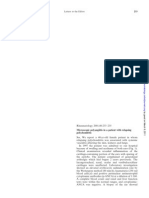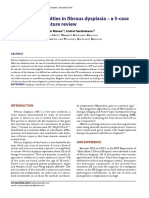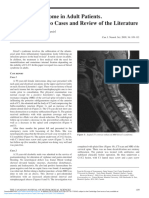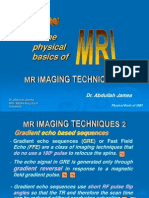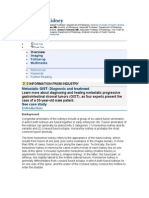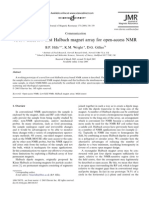Síndrome de Gradenigo #2
Síndrome de Gradenigo #2
Uploaded by
Arcel De Luca G.Copyright:
Available Formats
Síndrome de Gradenigo #2
Síndrome de Gradenigo #2
Uploaded by
Arcel De Luca G.Copyright
Available Formats
Share this document
Did you find this document useful?
Is this content inappropriate?
Copyright:
Available Formats
Síndrome de Gradenigo #2
Síndrome de Gradenigo #2
Uploaded by
Arcel De Luca G.Copyright:
Available Formats
Hindawi
Case Reports in Otolaryngology
Volume 2020, Article ID 9439184, 5 pages
https://doi.org/10.1155/2020/9439184
Case Report
Gradenigo’s Syndrome with Carotid Septic Stenosis
Ana Sousa Menezes ,1 Daniela Ribeiro,1 Filipa Balona,2 Ricardo Maré,3 Cátia Azevedo,1
Jaime Rocha,4 and Luı́s Dias1
1
Department of Otorhinolaryngology-Head and Neck Surgery, Hospital de Braga, Braga, Portugal
2
Department of Pediatrics, Hospital de Braga, Braga, Portugal
3
Department of Neurology, Hospital de Braga, Braga, Portugal
4
Department of Neuroradiology, Hospital de Braga, Braga, Portugal
Correspondence should be addressed to Ana Sousa Menezes; ana4644@gmail.com
Received 13 November 2019; Accepted 4 February 2020; Published 20 February 2020
Academic Editor: Abrão Rapoport
Copyright © 2020 Ana Sousa Menezes et al. This is an open access article distributed under the Creative Commons Attribution
License, which permits unrestricted use, distribution, and reproduction in any medium, provided the original work is
properly cited.
Gradenigo’s syndrome was firstly described in 1907 by Giusseppe Gradenigo and is defined as the clinical triad of suppurative
otitis media, ipsilateral abducens nerve palsy, and pain in the distribution of the first and the second branches of the trigeminal
nerve. Since the advent of antibiotics, the incidence of this potentially life-threatening complication has diminished, but oc-
casional cases still occur. We herein report a pediatric case of otitis media associated with Gradenigo’s syndrome complicated by
ipsilateral septic cavernous sinus thrombosis and infectious arteritis of the internal carotid artery.
1. Introduction 2. Case Presentation
Gradenigo’s syndrome (GS) has always been considered a An 8-year-old girl was admitted to the emergency depart-
classical condition, well known by many but currently seen ment with a 10-day history of left-sided otalgia, otorrhea,
by very few. In fact, GS has become a rare diagnosis in the and ipsilateral hearing loss and new onset strabismus and
modern antibiotic era [1–3]. binocular diplopia since the day of admission. She was under
Although being a rare and relatively forgotten process of paracetamol and ibuprofen every 4 hours since the begin-
years past, GS can be potentially life-threatening with sig- ning of the disease, with fever noticed only in day 4 and had
nificant mortality. Cerebral vascular thrombosis is a serious taken 1 dose of cotrimoxazole without medical prescription.
neurological complication of otitis media and occurs sec- She had been vomiting since the previous night, with no
ondary to spread of the infection to the underlying bone. headache or ocular pain. Her medical history was unre-
To the best of our knowledge, very few case reports have markable. Physical examination revealed suppurative left-
been published describing venous sinus thrombosis in GS, and sided acute otitis media, bilateral conductive hearing loss on
only two reported the commitment of the carotid artery [4–10]. acumetry with tuning forks, ipsilateral abducens nerve palsy
We believe it is of utmost importance to raise awareness (Figure 1), and a fever of 38.0°C. Sensation to light touch and
of these vascular complications of GS, which may allow for pinprick in the distribution of the fifth (trigeminal) cranial
early detection and treatment of one of the most serious nerve was preserved. No other focal neurological deficit was
complications of otitis media. Additionally, this case report present. Meningeal signs were negative.
emphasizes the importance of appropriate radiological in- The patient underwent contrast-enhanced computed
vestigation and timely treatment, which in our case included tomography (CT) which revealed left mastoiditis and a left
surgery and medical therapy. petrous apicitis (apical petrositis) with ipsilateral septic
2 Case Reports in Otolaryngology
Figure 1: Left lateral rectus palsy as demonstrated by the patient’s
inability to abduct her left eye.
cavernous sinus thrombosis and infectious arteritis and
stenosis of the internal carotid artery (Figure 2).
Ophthalmological assessment confirmed left lateral
rectus paralysis (Figure 1), with normal biomicroscopy,
fundoscopy, and normal visual acuity.
Blood tests revealed elevated inflammatory parameters
Figure 2: Axial temporal bone computed tomography (CT) scan
with a white blood cell (WBC) count of 26200/μL with 24500 showing opacification of the left middle ear and mastoid and
neutrophils/μL (93.4%) and C-reactive protein of 88.8 mg/L. expanded fluid-filled petrous apex.
Renal function and clotting were unremarkable.
Magnetic resonance imaging (MRI) showed a diffuse
inflammatory enhancement in the left mastoid air cells and the
petrous apex with extraosseous extension of the inflammatory
process to the petroclival suture and dura adjacent to the clivus
and petrous apex on the same side (Figures 3 and 4). Also,
inflammatory intense enhancement in the left carotid canal
with stenosis of about 50% of the petrous, lacerum, and
cavernous segments, and intense enhancement and swelling of
the cavernous sinus was seen (Figures 3–8).
The patient was diagnosed with GS based on her clinical
presentation, which included acute suppurative otitis media
with involvement of the sixth cranial nerve, and based on the
evidence of petrous apicitis (apical petrositis) on the CT. The
imaging studies also revealed the presence of cavernous
sinus thrombosis and carotid septic stenosis. Other differ-
ential diagnosis of petrous apicitis including congenital
cholesteatoma, intracranial abscess, lateral sinus thrombosis,
cholesterol granuloma, temporal bone osteomyelitis, and
neoplastic or granulomatous disease were excluded Figure 3: Axial STIR sequence magnetic resonance imaging (MRI)
according to the clinical and radiological presentation shows a diffuse bilateral inflammatory involvement of middle ear-
[10, 11]. mastoid with extension of the inflammatory process to petrous
Empirical intravenous antibiotic therapy with ceftriax- apex on the left side.
one (100 mg/kg/day), vancomycin (60 mg/kg/day, with a
need to increase the dose to 90 mg/kg/day to reach thera-
peutic levels), and metronidazole (40 mg/kg/day) was star- She completed 13 days of ceftriaxone (suspended due to
ted. Ofloxacin 0.3% ear drops were also initiated. rash) and 21 days of vancomycin and metronidazol with
Considering the internal carotid arteritis with significant complete resolution of clinical findings. Tapering of meth-
stenosis, corticoid therapy with methylprednisolone (2 mg/ ylprednisolone was uneventful. Antiplatelet therapy with
kg/day) and antiplatelet therapy with aspirin (4 mg/kg/day) aspirin was continued for 3 months.
were decided. The abducens nerve palsy totally disappeared 3 days after
She was submitted to left canal-wall-up mastoidectomy admission.
and myringotomy with tube placement with intraoperative The WBC count and C-reactive protein decreased and
findings of abundant purulent middle-ear effusion and the microbial culture from the middle-ear fluid isolated
granulation tissue in the mastoid cavity and middle ear. Streptococcus pyogenes susceptible to penicillin and eryth-
Postoperative management included intermediate care unit romycin. The blood culture was negative.
monitoring for the first week, followed by transfer to the A contrast-enhanced cranial MRI 10 days after admis-
pediatrics ward. sion revealed partial regression of inflammatory signs in the
Case Reports in Otolaryngology 3
Figure 4: Coronal T2-weighted image shows inflammatory in-
volvement of the left petrous apex and Meckel cavity with petrous Figure 6: Coronal contrast-enhanced T1-weighted image shows a
carotid stenosis. heterogeneous abnormal enhancement of left cavernous sinus.
Figure 7: TOF 3D MRI angiography at admission, showing
Figure 5: Coronal T2-weighted image reveals an expanded and narrowing of the petrous, cavernous, and terminal segments of the
heterogeneous cavernous sinus. left internal carotid artery corresponding to left internal carotid
arteritis.
mastoid cells and left petrous apex with total repermeabi-
lization of the carotid artery (Figure 9) always seen, and symptoms should be taken in the context of
On outpatient follow-up, at 3 months following hospital all the patients’ presenting symptoms, signs, and investi-
discharge, she presented complete clinical and radiological gations [12].
remission, without long-term sequelae. Our patient did not present facial sensation impairment.
The grommet tube was still in place at consultation, with Likewise, in Gradenigo’s original case series of 57 patients,
otherwise normal tympanic membrane. Pure tone audi- more than half of the cases did not follow the classical triad [1].
ometry was also normal at 4 months. Here, we highlight the importance of recognizing the
classical triad and not forgetting GS association with the
3. Discussion septic vascular commitment of the cavernous sinus and
carotid artery.
We report an atypical and potentially life-threatening case of Advances in imaging have assisted diagnosis and
GS. As previously reported, the typical triad of GS is not monitoring of GS [13]. In fact, any child presenting with
4 Case Reports in Otolaryngology
[14]. Recently, some authors have advocated for nonsurgical
intervention with intravenous antibiotic therapy [15]. In our
case, surgical treatment was decided, combined with anti-
biotic therapy due to the severity of clinical presentation
with vascular commitment. Indeed, surgical debridement is
necessary in very severe cases or cases resistant to medical
treatment alone [15]. Another case report by Janjua et al. of a
patient with GS with epidural abscess and internal carotid
arteritis has described a good response to myringotomy and
grommet insertion combined with antibiotic and antiplatelet
therapy [10]. However, the authors considered mastoidec-
tomy unnecessary given the partially opacified mastoid air
cells in the CT, which was not our case.
Regarding the choice of antibiotics for treatment of GS,
most authors advocate for the use of a cephalosporin an-
tibiotic along with metronidazole with or without the ad-
dition of vancomycin [10, 11]. Empirical intravenous
antibiotics should cover common agents involved in bac-
Figure 8: Axial diffusion-weighted imaging revealing the absence terial mastoiditis (Staphylococcus aureus, Streptococcus
of restricted diffusion of water within the cavernous sinus and the pneumoniae, Streptococcus pyogenes, and Pseudomonas
temporal bone, excluding the presence of abscess and aeruginosa) and anaerobic organisms can also be considered
cholesteatoma. [16, 17]. In our case, ceftriaxone, metronidazol, and van-
comycin were chosen preoperatively for empiric broad-
spectrum coverage for the most commonly seen organisms.
Our case report stands out for its relatively short intravenous
antibiotic therapy duration. Previous reports have described
variable intravenous antibiotic therapy between 10 and 64
days [12, 15]. Undoubtedly, petrositis caused by infection is
equivalent to osteomyelitis, which needs intensive and
prolonged antibiotic treatment to avoid relapse [15]. In our
case, we considered the 21 days of antibiotic therapy suf-
ficient given the complete resolution of symptoms in the
days after surgery.
Considering the MRI finding of internal carotid arteritis,
with significant carotid narrowing within the petrous bone,
antiplatelet therapy with low-dose aspirin and corticoid
therapy with methylprednisolone was decided. However, the
decision of using antiplatelet therapy and not using anti-
coagulant therapy despite the associated finding of intra-
cranial venous thrombosis was not taken lightly.
Anticoagulant therapy use is controversial in septic cerebral
venous sinus thrombosis in children [18]. A Cochrane re-
view of anticoagulation for cerebral venous sinus thrombosis
Figure 9: TOF 3D MRI angiography 10 days after treatment reveals
total recalibration of the internal carotid artery.
including two small randomized-controlled trials (79 pa-
tients) found a nonsignificant trend towards reduced death
and disability in the anticoagulated group [19]. Although
there are no pediatric randomized-controlled trials, anti-
acute otitis media with suspected intracranial complication coagulants are often used and seem to be safe and beneficial
should undergo imaging testing. CT scan is the first choice of in cases of cerebral venous sinus thromboses [18–20]. In our
imaging, since it is widely available and detects abnormal- patient, given the presence of carotid arteritis, the increased
ities in bone structures, including destruction of trabecular risk of carotid artery rupture and septic embolism with
bone and erosion of the petrous apex. MRI is more sensitive anticoagulation was a concern, having been decided not to
in detecting dural thickening and enhancement as well as initiate hypocoagulation and the use of antiplatelet therapy
intracranial complications and has the advantage of avoiding instead.
unnecessary radiation to the patient. A MRI angiography
may be performed to rule out signs of sinus thrombosis 4. Conclusion
[4, 13].
The ideal treatment for petrous apicitis is controversial GS is seldom seen in modern medicine, thanks to wide-
and typically depends on the severity of clinical presentation spread antibiotic use for the treatment of acute otitis media.
Case Reports in Otolaryngology 5
However, over the recent decade, the emerging problem of [8] K. S. Gulin, “Petrositis complicated by cavernous sinus
antibiotic resistant bacterial strains should make us alert for thrombosis,” Vestnik Otorinolaringologii, vol. 5, no. 5,
potential complications secondary to otitis media [21–23]. pp. 66-67, 1984.
Septic vascular commitment of the cavernous sinus and [9] M. A. Sakalinskas and O. A. Cherniauskene, “Case of pet-
carotid artery is a potentially life-threatening complication rositis complicated by thrombosis of many vessels of the skull,
the jugular vein, carotid artery and phlegomon of the neck,”
of GS. Therefore, prompt recognition and early intervention
Vestnik otorinolaringologii, vol. 33, no. 5, p. 111, 1971.
of petrous apicitis is vital to prevent the consequences of this [10] N. Janjua, M. Bajalan, S. Potter, A. Whitney, and F. Sipaul,
life-threatening condition. Despite the current trend of “Multidisciplinary care of a paediatric patient with Grade-
conservative management for GS, surgical treatment may nigo’s syndrome,” BMJ Case Reports, vol. 2016, 2016.
still be necessary in severe cases and may shorten the an- [11] A. K. Gadre and R. A. Chole, “The changing face of petrous
tibiotic therapy duration. apicitis-a 40-year experience,” The Laryngoscope, vol. 128,
In conclusion, awareness of rare but potentially fatal no. 1, pp. 195–201, 2018.
diagnoses like GS, coupled with prompt investigations is [12] N. Taklalsingh, F. Falcone, and V. Velayudhan, “Gradenigo’s
required for early recognition and timely management of syndrome with CSOM and meningitis, petrous apicitis, and
our patients. meningitis,” American Journal of Case Reports, vol. 18,
pp. 1039–1043, 2017.
[13] T. E. Rossor, Y. C. Anderson, N. B. Steventon, and L. M. Voss,
Ethical Approval “Conservative management of Gradenigo’s syndrome in a
child,” BMJ Case Reports, vol. 2011, 2011.
All procedures performed in studies involving human [14] N. Rossi, M. L. Swonke, L. Reichert, and D. Young, “Gra-
participants were in accordance with the ethical standards of denigo’s syndrome in a four-year-old patient: a rare diagnosis
the institutional and national research committee and with in the modern antibiotic era,” The Jorunal of Laryngology &
the 1964 Helsinki Declaration and its later amendments or Otology, vol. 133, no. 6, pp. 535–537, 2019.
[15] P. V. F. Jensen, M. S. Hansen, M. N. Møller, and J. P. Saunte,
comparable ethical standards.
“The forgotten syndrome? Four cases of Gradenigo’s syn-
drome and a review of the literature,” Strabismus, vol. 24,
Consent no. 1, pp. 21–27, 2016.
[16] M. Luntz, A. Brodsky, S. Nusem et al., “Acute mastoiditis—the
Informed consent was obtained from the parents of the antibiotic era: a multicenter study,” International Journal of
patient. Pediatric Otorhinolaryngology, vol. 57, no. 1, pp. 1–9, 2001.
[17] C. L. Jacobsen, M. A. Bruhn, Y. Yavarian, and M. Gaihede,
“Mastoiditis and Gradenigo’s syndrome with anaerobic
Conflicts of Interest bacteria,” BMC Ear, Nose and Throat Disorders, vol. 12, no. 1,
p. 10, 2012.
All authors declare that they have no conflicts of interest. [18] J. Rebelo, S. Nayan, K. Choong, M. Fulford, A. Chan, and
D. D. Sommer, “To anticoagulate? Controversy in the man-
agement of thrombotic complications of head & neck infec-
References tions,” International Journal of Pediatric Otorhinolaryngology,
vol. 88, pp. 129–135, 2016.
[1] G. Gradenigo, “Über die paralyse des nervus abducens bei
[19] J. Coutinho, S. F. de Bruijn, G. deVeber, and J. Stam,
otitis,” Archiv für Ohrenheilkunde, vol. 74, no. 1, pp. 149–187,
“Anticoagulation for cerebral venous sinus thrombosis,”
1907.
Cochrane Database of Systematic Reviews, vol. 8, no. 8, Article
[2] R. A. Chole and P. J. Donald, “Petrous apicitis—clinical
ID CD002005, 2011.
considerations,” Annals of Otology, Rhinology & Laryngology,
[20] G. deVeber, M. Andrew, C. Adams et al., “Cerebral sinove-
vol. 92, no. 6, pp. 544–551, 1983.
nous thrombosis in children,” New England Journal of
[3] N. A. Goldstein, M. L. Casselbrant, C. D. Bluestone,
Medicine, vol. 345, no. 6, pp. 417–423, 2001.
K.-L. Marcia, and P. Pittsburgh, “Intratemporal complications
[21] J. S. Zapalac, K. R. Billings, N. D. Schwade, and P. S. Roland,
of acute otitis media in infants and children,” Otolaryngology-
“Suppurative complications of otitis media in the era of
Head and Neck Surgery, vol. 119, no. 5, pp. 444–454, 1998.
antibiotic resistance,” Archives of Otolaryngology-Head &
[4] S. Özkaçmaz, “Acute otitis media associated with Gradenigo
Neck Surgery, vol. 128, no. 6, pp. 660–663, 2002.
syndrome and transverse sinus thrombosis: a case report,”
[22] M. C. Thorne, L. Chewaproug, and L. M. Elden, “Suppurative
Journal of International Medical Research, vol. 47, no. 3,
complications of acute otitis media: changes in frequency over
pp. 1348–1352, 2019.
time,” Archives of Otolaryngology-Head & Neck Surgery,
[5] A. Scardapane, M. Del Torto, M. Nozzi, C. Elio, L. Breda, and
vol. 135, no. 7, pp. 638–641, 2009.
F. Chiarelli, “Gradenigo’s syndrome with lateral venous sinus
[23] M. D. Poole, “Otitis media complications and treatment
thrombosis: successful conservative treatment,” European
failures: implications of pneumococcal resistance,” The Pe-
Journal of Pediatrics, vol. 169, no. 4, pp. 437–440, 2010.
diatric Infectious Disease Journal, vol. 14, no. Supplement,
[6] S. C. Sherman and A. Buchanan, “Gradenigo syndrome: a case
pp. S23–S36, 1995.
report and review of a rare complication of otitis media,” The
Journal of Emergency Medicine, vol. 27, no. 3, pp. 253–256,
2004.
[7] S. Hananya and Y. Horowitz, “Gradenigo syndrome and
cavernous sinus thrombosis in fusobacterial acute otitis
media,” Harefuah, vol. 133, no. 7-8, pp. 284–286, 1997.
You might also like
- Atlas of The Human BrainDocument458 pagesAtlas of The Human BrainjuanpgonzalezNo ratings yet
- Dyscalculia Research ProposalDocument26 pagesDyscalculia Research Proposalapi-347715993100% (1)
- Dca CPT CodesDocument1 pageDca CPT CodesaninnaNo ratings yet
- Gradenigo's Syndrome - A Rare Case Report: Medical SciencesDocument2 pagesGradenigo's Syndrome - A Rare Case Report: Medical SciencesSODAZZZANo ratings yet
- Case Report BM 1Document6 pagesCase Report BM 1Mohamad BasofiNo ratings yet
- Management of Gradenigo Syndrome in A ChildDocument4 pagesManagement of Gradenigo Syndrome in A ChildmitaNo ratings yet
- C CA AS SC CL Liin Niiq QU UE E // C CA AS SE ER RE EP PO OR RT TDocument7 pagesC CA AS SC CL Liin Niiq QU UE E // C CA AS SE ER RE EP PO OR RT TG Virucha Meivila IINo ratings yet
- Gradenigo SyndromeDocument7 pagesGradenigo SyndromeYayan AkhyarNo ratings yet
- Maxillary Sinusitis Complicated by Stroke: SciencedirectDocument3 pagesMaxillary Sinusitis Complicated by Stroke: SciencedirectputraNo ratings yet
- SD GradiDocument3 pagesSD GradiPabloMrchNo ratings yet
- TromboflebitisDocument3 pagesTromboflebitismuthiadewi31No ratings yet
- Bezold AbscessDocument5 pagesBezold AbscessCarimaGhalieNo ratings yet
- Para-Aortic and Meningitis Tuberculosis: A Case Report: BackgroundDocument10 pagesPara-Aortic and Meningitis Tuberculosis: A Case Report: BackgroundAseta MedikaNo ratings yet
- Case Report: Evaluating Complications of Chronic SinusitisDocument4 pagesCase Report: Evaluating Complications of Chronic SinusitiswilliampoluanNo ratings yet
- Invasive Sino-Aspergillosis in ImmunocompetentDocument5 pagesInvasive Sino-Aspergillosis in Immunocompetentabeer alrofaeyNo ratings yet
- Toorthj 6 445Document4 pagesToorthj 6 445Sonia RogersNo ratings yet
- Pleural MesotheliomaDocument4 pagesPleural MesotheliomablawosusiNo ratings yet
- Radiologic and Clinical Findings in Tuberculous MeningitisDocument6 pagesRadiologic and Clinical Findings in Tuberculous MeningitisAustine OsaweNo ratings yet
- Tuberculosis of Sphenoid Sinus Report of Two CasesDocument4 pagesTuberculosis of Sphenoid Sinus Report of Two CasesDevikaNo ratings yet
- Mediastinal Tuberculous Lymphadenitis Presenting With Insidious Back Pain in A Male Adult: A Case Report and Review of The LiteratureDocument7 pagesMediastinal Tuberculous Lymphadenitis Presenting With Insidious Back Pain in A Male Adult: A Case Report and Review of The Literaturez9tpwgb5nwNo ratings yet
- Sindrom GradenigoDocument5 pagesSindrom GradenigoKelompok F8 CoasNo ratings yet
- Severe Intracranial and Extracranial Complications of The Middle Ear Cholesteatoma A Report CaseDocument5 pagesSevere Intracranial and Extracranial Complications of The Middle Ear Cholesteatoma A Report CaseChoirul UmamNo ratings yet
- AbscessDocument12 pagesAbscesslittlecandiesNo ratings yet
- 233 FullDocument3 pages233 FullShashi LimbachiyaNo ratings yet
- Case Report: Tuberculous Spondylitis: A Report of Different Clinical Scenarios and Literature UpdateDocument5 pagesCase Report: Tuberculous Spondylitis: A Report of Different Clinical Scenarios and Literature UpdatepuaanNo ratings yet
- Tuberculous Spondylitis PDFDocument5 pagesTuberculous Spondylitis PDFpuaanNo ratings yet
- Neck Swelling: Unusual Manifestation of Pott's Spine: Egyptian Journal of Ear, Nose, Throat and Allied SciencesDocument3 pagesNeck Swelling: Unusual Manifestation of Pott's Spine: Egyptian Journal of Ear, Nose, Throat and Allied SciencesSonia RogersNo ratings yet
- Gradenigos Syndrome a Diagnostic ChallengeDocument3 pagesGradenigos Syndrome a Diagnostic ChallengeScivision PublishersNo ratings yet
- P ('t':3) Var B Location Settimeout (Function (If (Typeof Window - Iframe 'Undefined') (B.href B.href ) ), 2000)Document9 pagesP ('t':3) Var B Location Settimeout (Function (If (Typeof Window - Iframe 'Undefined') (B.href B.href ) ), 2000)zano_adamNo ratings yet
- 1882-Article Text-7722-1-10-20200608 PDFDocument6 pages1882-Article Text-7722-1-10-20200608 PDFRyanNo ratings yet
- Tome IiDocument207 pagesTome IiemnaNo ratings yet
- JurnalDocument9 pagesJurnalMelita Amalia AyubaNo ratings yet
- 1084-4673-2-PBDocument5 pages1084-4673-2-PBSpongebob zzNo ratings yet
- Case Report OtologyDocument14 pagesCase Report OtologyZiha Zia Leonita FauziNo ratings yet
- Tuberculous Coxitis: Diagnostic Problems and Varieties of Treatment: A Case ReportDocument4 pagesTuberculous Coxitis: Diagnostic Problems and Varieties of Treatment: A Case Reportnur afrinda mulyaNo ratings yet
- PDF TJP 1795Document5 pagesPDF TJP 1795lathifatulNo ratings yet
- Fvets 07 00122Document6 pagesFvets 07 00122Lucas XavierNo ratings yet
- Intratonsillar AbscessDocument4 pagesIntratonsillar AbscessJuthika Rai ShettyNo ratings yet
- Aijoc 14 1Document6 pagesAijoc 14 1Yosua AristarkhusNo ratings yet
- Primary Conjunctival Tuberculosis-2Document3 pagesPrimary Conjunctival Tuberculosis-2puutieNo ratings yet
- Disseminated Necrotic Mediastinitis Spread From Odontogenic Abscess: Our ExperienceDocument10 pagesDisseminated Necrotic Mediastinitis Spread From Odontogenic Abscess: Our ExperienceVenter CiprianNo ratings yet
- Rhizomucor Scedosporium: Case ReportDocument6 pagesRhizomucor Scedosporium: Case ReportPaul ColburnNo ratings yet
- Malignant Otitis External-Our Experience: R. B. Sardesai, T. KrishnakumarDocument4 pagesMalignant Otitis External-Our Experience: R. B. Sardesai, T. KrishnakumarSuci PramadianiNo ratings yet
- Fulltext Ajo v2 Id1026Document3 pagesFulltext Ajo v2 Id1026Lavenia Ellein MokiwangNo ratings yet
- Otitis 1Document1 pageOtitis 1Raja Friska YulandaNo ratings yet
- Improvement of Complete Oculomotor Cranial Nerve Palsy With PupillaryDocument11 pagesImprovement of Complete Oculomotor Cranial Nerve Palsy With PupillarydnazaryNo ratings yet
- Diagnostic Difficulties in Fibrous Dysplasia - A 5-Case Series and A Literature ReviewDocument9 pagesDiagnostic Difficulties in Fibrous Dysplasia - A 5-Case Series and A Literature Reviewsolikin ikinNo ratings yet
- Case Report: Hyperprolactinemia Secondary To Allergic Fungal Sinusitis Compressing The Pituitary GlandDocument4 pagesCase Report: Hyperprolactinemia Secondary To Allergic Fungal Sinusitis Compressing The Pituitary GlandfuadizzuddinNo ratings yet
- Malignant Otitis Externa 20070821Document0 pagesMalignant Otitis Externa 20070821Suci PramadianiNo ratings yet
- Citrobacter Koseri Meningitis: A Neurosurgical Condition?Document4 pagesCitrobacter Koseri Meningitis: A Neurosurgical Condition?SukumarNo ratings yet
- Cavernous Sinus Thrombosis 2Document4 pagesCavernous Sinus Thrombosis 2Putu WidiastriNo ratings yet
- 7 DF 0Document5 pages7 DF 0antonioskrasoudakisNo ratings yet
- Brucilosis and TB ArticleDocument4 pagesBrucilosis and TB Articlesana shakeelNo ratings yet
- Diagnosis of Brown Sequard SyndromeDocument3 pagesDiagnosis of Brown Sequard SyndromeOktavianus PrayitnoNo ratings yet
- London F, Acta Neurol Belg, 2023Document4 pagesLondon F, Acta Neurol Belg, 2023Fabrizio Quiñonez FlorentinNo ratings yet
- A Rare Cause of Endocarditis: Streptococcus PyogenesDocument3 pagesA Rare Cause of Endocarditis: Streptococcus PyogenesYusuf BrilliantNo ratings yet
- Primary Osteosarcoma of The Nasal Fossa: An Exceptional PresentationDocument5 pagesPrimary Osteosarcoma of The Nasal Fossa: An Exceptional PresentationRian HasniNo ratings yet
- Case Report: Retropharyngeal Calcific Tendonitis Mimics A Retropharyngeal AbscessDocument5 pagesCase Report: Retropharyngeal Calcific Tendonitis Mimics A Retropharyngeal AbscessAlni DiniatyNo ratings yet
- Knots and Knives - 3rd EditionsDocument4 pagesKnots and Knives - 3rd EditionsNasser AlbaddaiNo ratings yet
- Paker 2018Document4 pagesPaker 2018Reema AlsogairNo ratings yet
- Jaw Pain, Pain On Deep Inspiration, and Severe Odynophagia in An 18-Year-Old BoyDocument6 pagesJaw Pain, Pain On Deep Inspiration, and Severe Odynophagia in An 18-Year-Old BoySamNo ratings yet
- Anti-Neutrophil Cytoplasmic Antibody (ANCA) Associated VasculitisFrom EverandAnti-Neutrophil Cytoplasmic Antibody (ANCA) Associated VasculitisRenato Alberto SinicoNo ratings yet
- Practical Management of Systemic Sclerosis in Clinical PracticeFrom EverandPractical Management of Systemic Sclerosis in Clinical PracticeNo ratings yet
- 600 Machine Learning DL NLP CV ProjectsDocument16 pages600 Machine Learning DL NLP CV ProjectsBalaji100% (2)
- 2015-Accuracy of Subthalamic Nucleus Targeting by T2, FLAIRDocument8 pages2015-Accuracy of Subthalamic Nucleus Targeting by T2, FLAIRPaul RodrigoNo ratings yet
- Brain SpectDocument10 pagesBrain SpectKevinNo ratings yet
- A Histoarchitectural Approach To Skeletat Muscle InjurieDocument9 pagesA Histoarchitectural Approach To Skeletat Muscle InjurieJesúsNo ratings yet
- Prelim Physio PsychDocument28 pagesPrelim Physio PsychRM April AlonNo ratings yet
- Mri ReportDocument2 pagesMri ReportArnav GuptaNo ratings yet
- Filippi Assessment Lesions MRI in MSDocument18 pagesFilippi Assessment Lesions MRI in MSAlfonso LemaNo ratings yet
- Biomedical Imaging Technology: BY 17RH1A04E1Document10 pagesBiomedical Imaging Technology: BY 17RH1A04E1Gagana ChowdaryNo ratings yet
- Guidelines For The Management of Spontaneous Intracerebral HemorrhageDocument30 pagesGuidelines For The Management of Spontaneous Intracerebral HemorrhageM Fathur Arief KurniawanNo ratings yet
- Nabh Application HospitalDocument43 pagesNabh Application HospitalVivek AnandanNo ratings yet
- Gray's Anatomy For Students Flash Cards: Gray's Anatomy For Students Flash Cards E-Book., 978-0323639170Document23 pagesGray's Anatomy For Students Flash Cards: Gray's Anatomy For Students Flash Cards E-Book., 978-0323639170liviaburleighcv100% (9)
- Syllabus 5TH SemDocument7 pagesSyllabus 5TH SemarivasanthNo ratings yet
- Dott. Ing. Letizia Squarcina, PH.D.: Tecniche Di Analisi Di MRI Cerebrale Neuroscience and PsychiatryDocument39 pagesDott. Ing. Letizia Squarcina, PH.D.: Tecniche Di Analisi Di MRI Cerebrale Neuroscience and PsychiatryLaura RossiNo ratings yet
- Rapid T2-Weighted Turbo Spin Echo MultiVane Brain MRI Using Compressed SENSE A Qualitative AnalysisDocument8 pagesRapid T2-Weighted Turbo Spin Echo MultiVane Brain MRI Using Compressed SENSE A Qualitative AnalysisBella YulandaNo ratings yet
- Radlink Issue 2 2008Document2 pagesRadlink Issue 2 2008RadlinkSingaporeNo ratings yet
- MRI For Dummies Part2 GallezDocument27 pagesMRI For Dummies Part2 GallezIrina Ionete100% (1)
- 2 - Pulse Sequence Gradient Echo - PRNDocument45 pages2 - Pulse Sequence Gradient Echo - PRNoneloveyouNo ratings yet
- Horseshoe KidneyDocument26 pagesHorseshoe KidneyarjunjaidevNo ratings yet
- KLP 10 - Jurnal - MeningiomaDocument11 pagesKLP 10 - Jurnal - Meningiomawahy udiNo ratings yet
- Improved PNLM Filtering Technique Using GLCM AlgorithmDocument5 pagesImproved PNLM Filtering Technique Using GLCM AlgorithmAnonymous izrFWiQNo ratings yet
- MRI Detailed SpecDocument25 pagesMRI Detailed SpecMed MahmoudNo ratings yet
- GCT ThumbDocument10 pagesGCT ThumbMoeez AkramNo ratings yet
- A Low Field, Low Cost Halbach Magnet Array For Open Access NMRDocument4 pagesA Low Field, Low Cost Halbach Magnet Array For Open Access NMRaresnickety100% (3)
- Nanoparticles For Diagnostic Imaging andDocument12 pagesNanoparticles For Diagnostic Imaging andBrunaNo ratings yet
- Przydatność Angiografii Rezonansu Magnetycznego ARTYKUŁDocument9 pagesPrzydatność Angiografii Rezonansu Magnetycznego ARTYKUŁsyker666No ratings yet
- Noise Ratio Pada Pembobotan T2 Turbo Spin Echo: Jimed, Vol. 3, No. 2 Issn 2356-301XDocument6 pagesNoise Ratio Pada Pembobotan T2 Turbo Spin Echo: Jimed, Vol. 3, No. 2 Issn 2356-301Xrizky maulidiyahNo ratings yet
- Cooley - Design of Sparse Halbach Magnet Arrays For Portable MRI Using A Genetic AlgorithmDocument12 pagesCooley - Design of Sparse Halbach Magnet Arrays For Portable MRI Using A Genetic AlgorithmSumitNo ratings yet























